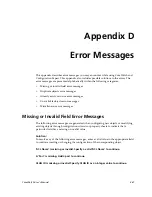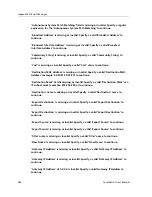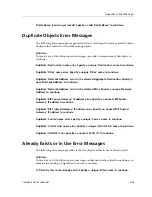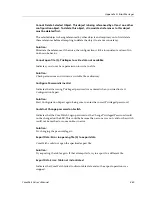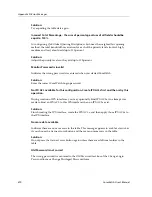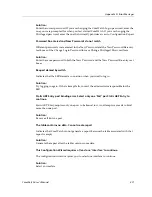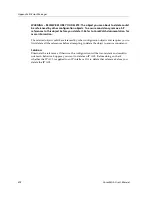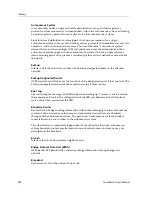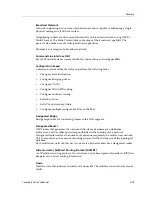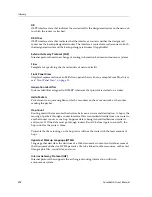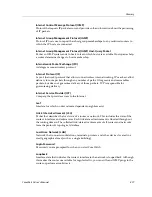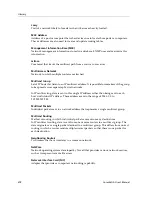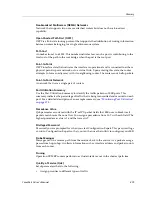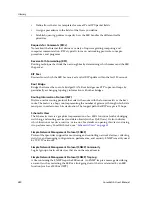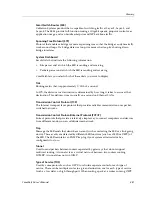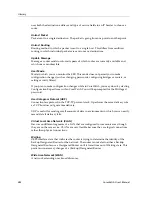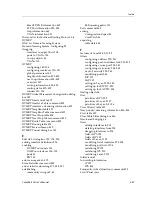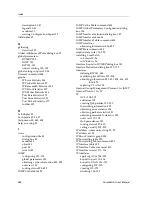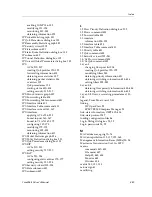
CoreWatch User’s Manual
475
Glossary
Broadcast Network
Network supporting two or more attached routers and is capable of addressing a single
physical message to all of those routers.
Neighboring routers are discovered dynamically on broadcast networks using OSPF’s
Hello Protocol. The Hello Protocol takes advantage of the broadcast capability. The
protocol also makes use of existing multicast capabilities.
Ethernet is an example of a broadcast network.
Command Line Interface (CLI)
Set of Cabletron Systems commands that let you monitor and configure SSRs.
Configuration Expert
Cabletron Systems utility that lets you perform the following tasks:
•
Change system information
•
Configure bridging polices
•
Configure VLANs
•
Configure IP and IPX routing
•
Configure multicast routing
•
Set QoS policies
•
Set ACLs and security filters
•
Configure multiple configuration files on the SSR
Designated Bridge
Bridge responsible for forwarding frames to the LAN segment.
Designated Router
OSPF router that generates the network's link-state advertisement, establishes
adjacencies, and has other special responsibilities in the running of the protocol.
Designated routers reduce the number of adjacencies required on a multi-access network.
This in turn reduces the amount of routing protocol traffic and the size of the topological
database.
Each multiaccess network that has two or more attached routers has a designated router.
Distance Vector Multicast Routing Protocol (DVMRP)
An IP multicast routing protocol. It is a distance-vector based protocol (similar to RIP) that
keeps its own unicast routing information.
Down
Interface state that indicates an interface is unusable. The interface cannot send or receive
traffic.
Summary of Contents for CoreWatch
Page 1: ...CoreWatch User s Manual 9032564 04...
Page 2: ...Notice 2 CoreWatch User s Manual...
Page 20: ...Preface 20 CoreWatch User s Manual...
Page 64: ...Chapter 5 Changing System Settings 64 CoreWatch User s Manual...
Page 86: ...Chapter 6 Configuring SSR Bridging 86 CoreWatch User s Manual...
Page 106: ...Chapter 7 Configuring VLANs on the SSR 106 CoreWatch User s Manual...
Page 206: ...Chapter 12 Configuring QoS on the SSR 206 CoreWatch User s Manual...
Page 246: ...Chapter 13 Configuring Security on the SSR 246 CoreWatch User s Manual...
Page 363: ...CoreWatch User s Manual 363 Chapter 16 Configuring Routing Policies on the SSR 9 Click OK...
Page 364: ...Chapter 16 Configuring Routing Policies on the SSR 364 CoreWatch User s Manual...
Page 370: ...Chapter 17 Checking System Status 370 CoreWatch User s Manual...
Page 390: ...Chapter 18 Monitoring Real Time Performance 390 CoreWatch User s Manual...
Page 396: ...Chapter 19 Checking the Status of Bridge Tables 396 CoreWatch User s Manual...
Page 430: ...Chapter 20 Checking the Status of Routing Tables 430 CoreWatch User s Manual...
Page 442: ...Chapter 22 Obtaining Reports 442 CoreWatch User s Manual...
Page 456: ...Appendix B CoreWatch Menus 456 CoreWatch User s Manual...

